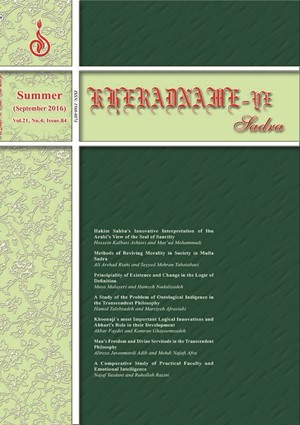Hakim Sahba’s Innovative Interpretation of Ibn Arabi’s View of the Seal of Sainthood
Subject Areas : مطالعات حوزه عرفان و کلام اسلامی
1 - دانشگاه علامه طباطبائی
Keywords: Sainthood seal of sainthood seal of saints Muhammedan truth Hakim Sahba Ibn Arabi ,
Abstract :
There are some disagreements among the commentators of Ibn Arabi’s works regarding his idea of the seal of saints, and various interpretations have been put forward in this respect. The reason for this variety is that he has introduced different people as the seal of sainthood. Among his commentators, only Aqa Mohammad Reza Ghomshei (known as Hakim Sahba, 1234-1306 AH), the theologian philosopher, has succeeded in presenting a reading of Ibn Arabi’s idea of the problem of the seal of sainthood based on an innovative interpretive plan while using a new way of expressing the problem. This interpretation clearly reveals who and what the seal of sainthood is. Hakim Sahba believes that Ibn Arabi considered various applications for the seal of sainthood, and wherever he introduced a specific person as the seal of sainthood, he had a particular application in mind. In Hakim Sahba’s view, Ibn Arabi considered two applications for the seal of sainthood and divided each into two types which are against each other. In the first application, he divided sainthood into absolute and limited ones, and in the second application into general and particular ones. Then he introduced a seal of sainthood for each of these types. By limited, he meant being limited to a name and a limit and, by absolute, he meant being free from any kind of limitation so that the saint would be inclusive of all names, attributes, and essential epiphanies. General sainthood is for all believers; however, particular sainthood is exclusively for Prophet Muhammed (s) and his heirs.
ساية نور؛ گزيدة مقالات كنگرة بزرگداشت عارف الهي آقامحمدرضا قمشهاي(صهبا)، انجمن آثار و مفاخر فرهنگي استان اصفهان، كانون پژوهش.#
آشتياني، سيد جلالالدين، مقدمه بر كتاب شرح دعاي عرفه حاجي خراساني، آستان قدس رضوي، بيتا.#
آشتياني، سيد جلالالدين، شرح مقدمة قيصري، بوستان كتاب، 1378.#
آملي، سيدحيدر، جامع الاسرار و منبع الانوار، تصحيح هانري كربن و عثمان اسماعيل يحيي، انتشارات علمي و فرهنگي، 1393.#
آملي، سيدحيدر، مقدمه نص النصوص في شرح الفصوص، ترجمه محمدرضا جوزي، انتشارات روزنه، 1395.#
آملي، سيدحيدر، نص النصوص في شرح الفصوص، ج1 و 2، تحقيق بيدارفر، انتشارات بيدار، 1394.#
ابن تركه اصفهاني، صائن الدين، تمهيد القواعد، تصحيح سيد جلال الدين آشتياني، بوستان كتاب، 1381.#
ابن عربي، عنقاء مغرب في ختم الاولياء و الشمس المغرب، تحقيق عاصم ابراهيم كيالي، چاپ بيروت، 1971م.#
ابن عربي، الفتوحات المكيه، ج1و2و3و4، تحقيق عثمان يحيي، چاپ مصر، 1405.#
ابن عربي، فصوص الحكم، تحقيق محمد خواجوي، انتشارات مولي، 1393.#
امام خميني، تقريرات فلسفه، ج2، تحقيق سيدعبدالغني اردبيلي، مؤسسه تنظيم و نشر آثار امام خميني، 1392.#
امام خميني، مصباح الهدايه الي الخلافه و الولايه، مؤسسه چاپ و نشر عروج، 1389.#
جندي، مؤيدالدين، شرح فصوص الحكم، تحقيق سيد جلالالدين آشتياني، بوستان كتاب، 1381.#
جوادي آملي، عبدالله، تحرير رساله الولايه، مركزنشر اسراء، 1393.#
جهانگيري، محسن، محي الدين ابن عربي چهره برجسته عرفان اسلامي، انتشارات دانشگاه تهران، 1390.#
قيصري، رسائل، تحقيق سيدجلال الدين آشتياني، مؤسسه پژوهشي حكمت و فلسفه ايران، 1381.#
طباطبايي، سيدمحمدحسين، رسالة الولايه، تحقيق صادق حسن زاده، انتشارات آيت اشراق، 1393.#
فرغاني، سعيد الدين سعيد، مشارق الدراري، تحقيق سيد جلال الدين آشتياني، انتشارات بوستان كتاب، 1392.#
فيض كاشاني، مولي محسن،كلمات مكنونه، تصحيح علي عليزاده، انتشارات آيت اشراق، 1390.#
قمشهاي، محمدرضا، مجموعه آثار حكيم صهبا، تحقيق حامد ناجي اصفهاني، انتشارات آيت اشراق، 1394.#
قونوي، صدرالدين، فكوك، تصحيح محمد خواجوي، انتشارات مولي، 1385.#
قيصري، داوود، شرح فصوص الحكم، تحقيق سيدجلالالدين آشتياني، انتشارات علمي وفرهنگي.#
كاشاني، عبدالرزاق، شرح فصوص الحكم، شركت مصطفي البابي الحلبي، 1407.#
مطهري، مرتضي، شش مقاله، انتشارات صدرا، 1389.#
